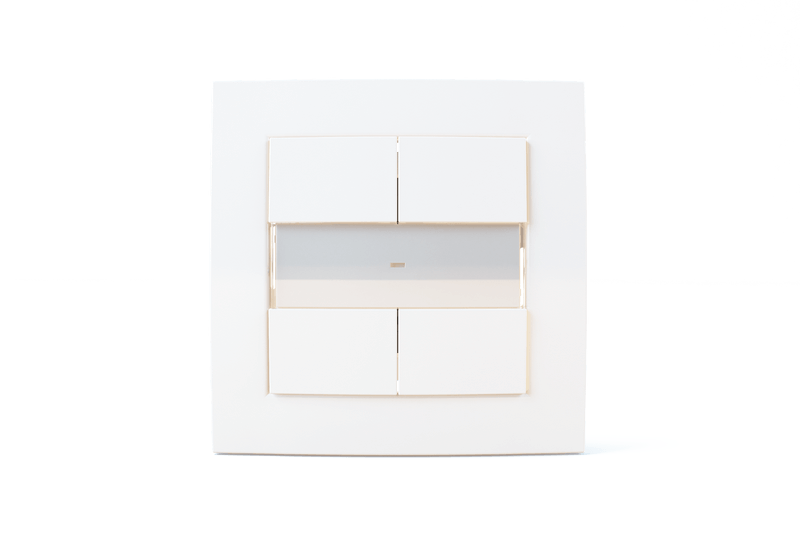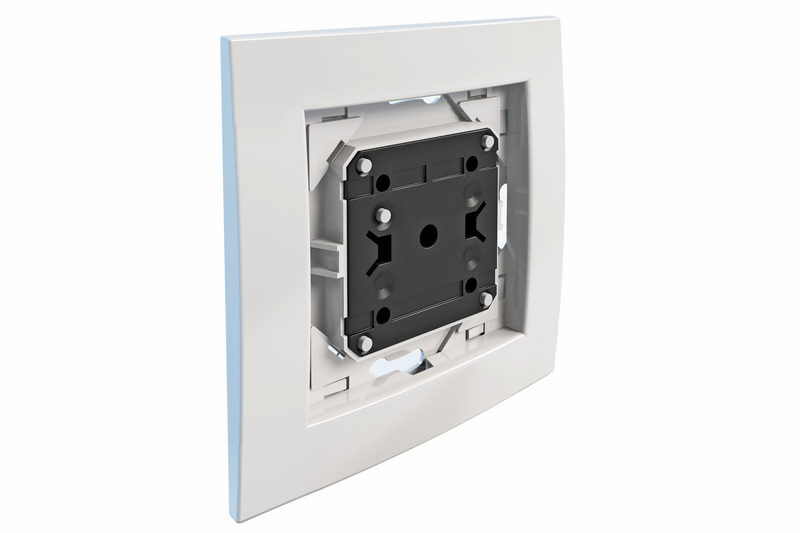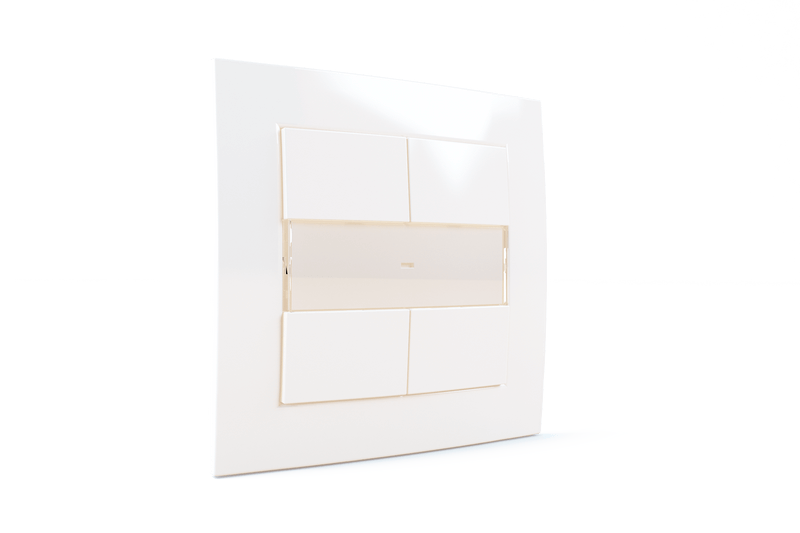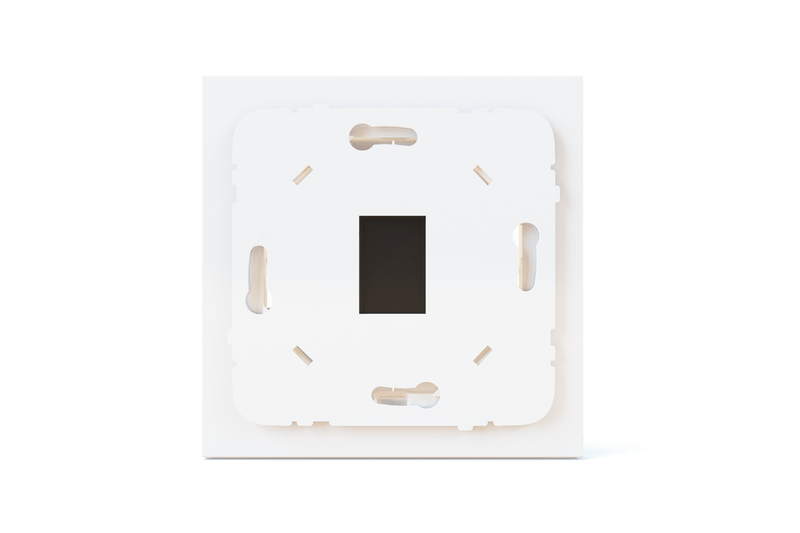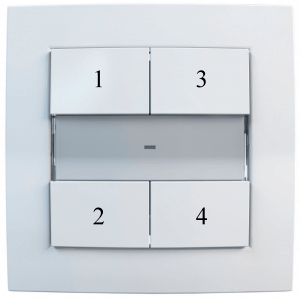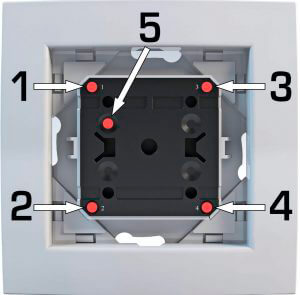The battery-operated radio switch CH-404 - can control other devices. The device supports commands such as: on, off, dimming, as well as starting scenes on the central controller. The switch is compact and can easily be placed in any convenient location. An extensive choice of colors and materials thanks to the design of the Logus 90 switch range (EFAPEL Portugal).
Advantages of the CH-404:
-
-
- Позволяет управлять устройствами напрямую, не используя контроллер;
- Runs on one battery for 2 years*;
- Signals a low battery condition;
- Easy setup and installation. Can be placed anywhere convenient for you;
- Can control devices using a secure data channel;
- Has the ability to control multi-level devices such as: dimmer (for example: CH-301), control module of curtains, shutters, blinds (for example: CH-103), etc;
- Send preset scenes (Scene Activation Set). Refer to your controller's manual for support for such commands;
- Совместим с большинством контроллеров.
-
* Provided the switch is used 2 presses per day.
Complete
-
-
- 1. CH-404 device (version 2.1)
- 2. User's Manual;
- 3. a CR2032 battery;
- 4. Double-sided tape;
- 5.Double-sided tape;
-
THE CH-404 DEVICE SUPPORTS THE FOLLOWING COMMANDS:
-
-
- Enable;
- Off;
- Enable at the set value;
- Sending multilevel commands to such devices as: dimmer (Example: CH-301), blinds, roller shutters control module (Example: CH-103);
- Send preset scenes (Scene Activation Set). Refer to your controller's user manual for support for such commands;
-
Technical Specifications
| Meals: | CR2032 3v Battery |
| Operating temperature | 0°C to 40°C |
| Radio signal strength | 2 mW |
| Radio frequency | 868,4 MHz EU;
869,2 MHz RU; |
| Indoor range | Up to 45 m |
| Operating radius in open space | Up to 75 m |
| Device dimensions | 66.87мм*66.87мм*11мм |
| Minimum battery life | 3,000 keystrokes |
| Degree of protection CH-404 | IP-30 |
Device control
The CH-404 device controls other devices with a 4-button switch.
Connecting the device
The device operates like an ordinary wall switch from a "CR2032" battery
We recommend, for convenience, to add the wall controller to the network before installing the switch in its permanent place, to adjust the parameters and, if necessary, the connections of the device in the vicinity of the controller.
STEP 1
-
-
- 1 - Button #1;
- 2 - Button #2;
- 3 - Button #3;
- 4 - Button #4;
- 5 - System button.
-
STEP 2.
To add a switch to the network, put the controller into teaching mode (see your controller's manual) and hold down the system button until the LED blinks red, then release the button (Figure 2).
If there is a problem connecting the device to your network, you must go through the network exclusion procedure and then repeat the add procedure.
To remove (exclude) the switch from the network, put the controller into the exclusion mode (see controller manual) and hold down the system button until the LED blinks red and then release the button. Please note, once the unit is excluded from the network, all the settings you have made will be reset to the factory settings.
STEP 3
Attach the CH-404 to the wall or other surface using the adhesive tape or self-tapping screws provided.
STEP 4
Use your network's master controller to assign the devices that the CH-404 will control. To do this, add the controlled devices to the appropriate link groups, and select the types of commands the CH-404 will send to the controlled devices (Refer to the user manual of your host controller to configure the links and parameters).
Parameters
Warning. The CH-404 is a battery operated device. In order to increase its lifetime, the CH-404 is constantly in sleep mode. After adding parameters, wake up the device by pressing the system button to apply the settings.
Selects the command that will be sent to the corresponding linkage group, depending on the state (press or hold) of the button.
0 Turn off when pressed / dimming down when held down;
1 Turn on when pressing / holding dimming upwards (Default);
2 Scene activation depending on the state of the buttons (see the table of scenes). If you select this value, you must add the controller to the 2nd group of links.
Selects the command that will be sent to the corresponding linkage group, depending on the state (press or hold) of the button.
0 Turn off when pressed / dimming down when held down;
1 Turn on when pressing / holding dimming upwards (Default);
2 Scene activation depending on the state of the buttons (see the table of scenes). If you select this value, you must add the controller to the 2nd group of links.
Selects the command that will be sent to the corresponding linkage group, depending on the state (press or hold) of the button.
0 Turn off when pressed / dimming down when held down;
1 Turn on when pressing / holding dimming upwards (Default);
2 Scene activation depending on the state of the buttons (see the table of scenes). If you select this value, you must add the controller to the 2nd group of links.
Selects the command that will be sent to the corresponding linkage group, depending on the state (press or hold) of the button.
0 Turn off when pressed / dimming down when held down;
1 Turn on when pressing / holding dimming upwards (Default);
2 Scene activation depending on the state of the buttons (see the table of scenes). If you select this value, you must add the controller to the 2nd group of links
This parameter specifies a fixed value to send to multilevel devices that are in Linkage Group No. 7, for example: open the roller shutter at 30%. The allowable value is 1 - 99.
0 Disabled (Default).
This parameter specifies a fixed value to send to multilevel devices that are in Linkage Group No. 8, for example: open roller shutters at 30%. The allowable value is 1 to 99.
0 Disabled (Default).
This parameter specifies a fixed value to send to multilevel devices that are in Linkage Group No. 9, for example: open roller shutters at 30%. The allowable value is 1 - 99.
0 Disabled (Default).
This parameter specifies a fixed value to send to multilevel devices that are in Linkage Group #10, for example: open roller shutters at 30%. The allowable value is 1 - 99.
0 Disabled (Default).
The parameter is responsible for the frequency of sending the battery capacity report. Each press of any button specified in this parameter will send a battery capacity report to the first group of links.
The permissible value is 0-255;
0 Disabled (Default).
10 (Default).
The parameter specifies the switch hold time, after which the device will send a command to start dimming. The unit of measure used in the parameter is 0.1 seconds (10 = 1 second).
The permissible value is 1-255;
0 LED is off;
1 LED on (Default).
Scenes
Scene - a set of parameters for controlling several devices in the network and processing these parameters with the controller.
Refer to the user manual of your controller
Table of scenes
| Scene Activation | Switch 1 | Switch 2 | Switch 3 | Switch 4 |
| Clicking | Scene #11 | Scene #22 | Scene #33 | Scene #44 |
| Double-click | Scene #12 | Scene #23 | Scene #34 | Scene #45 |
| Triple-click | Scene #13 | Scene #24 | Scene #35 | Scene #46 |
| Withholding | Scene #14 | Scene #25 | Scene #36 | Scene #47 |
| Released | Scene #15 | Scene #26 | Scene #37 | Scene #48 |
Related
Devices can communicate with each other as well as exchange data and other information directly without the controller's involvement, through links. Each event (button short press, double press, triple press, button hold, and button release after hold) can have its own list of recipients, called a group of links. Refer to your controller's user manual to configure the links.
Some controllers may automatically be added to all link groups. For proper operation, add only those devices that the CH-404 will control to the appropriate link groups, and leave unused groups blank.
Warning. The CH-404 is a battery operated device. In order to increase the lifetime, the CH-404 is constantly in sleep mode. After adding devices to communication groups, wake up the device by pressing the system button to apply the settings (Figure 2).
LINK GROUPS CH-404:
-
-
- Group 1 - device (recommended controller), which will receive reports on the battery charge. The size of the group is 3 devices;
- Group 2 - devices that will receive the Scene activation set command. The size of the group is 3 devices;
- Group 3 - devices that will receive On/Off command when button #1 is pressed. The size of the group is 5 devices;
- Group 4 - devices that will receive On/Off command when button #2 is pressed. The size of the group is 5 devices;
- Group 5 - devices that will receive On/Off command when button #3 is pressed. The size of the group is 5 devices;
- Group 6 - devices that will receive On/Off command when button #4 is pressed. The size of the group is 5 devices;
- Group 7 - devices that will receive a dimming/open up/down command when button #1 is held down. The size of the group is 5 devices;
- Group 8 - devices that will receive a dimming/open up/down command when button #2 is held down. The size of the group is 5 devices;
- Group 9 - devices that will receive a dimming/open up/down command when button #3 is held down. The size of the group is 5 devices;
- Group 10 - devices that will receive the command to dimming/open up/down when you hold down button #4. The size of the group is 5 devices.
-
Manufacturer's warranty.
The warranty period is 1 year from the date of sale. Products that were transported, stored, assembled and operated with violations of the requirements for these products, as well as having mechanical damage - warranty replacement is not subject to the warranty.
Do not use the unit in any way other than that specified in this manual. The manufacturer shall not be liable for any warranty in case of improper use, modification or painting of the device. Immediately after opening the package, be sure to check the device for damage. If there is visible damage, do not connect or use the device.
Briefly about the C-Home system
All C-Home devices use a reliable and completely safe radio channel, on the basis of which the modules are combined with each other in a single network, which allows you to receive and transmit control signals to other devices in the network, using intermediate neighboring nodes.
The C-Home system has the ability to automatically reconstruct data transmission routes, depending on external factors, for example, if there is an obstacle between two neighboring devices, the signal will go through other nodes in the network in range.
C-Home is a two-way network. The devices can not only send control commands, but also wait for confirmation of their delivery and query the current status of the device. If the sending was not successful, the system tries to send the command another way.
The central element of the C-Home network is the Butler, which stores information about the network topology. It allows you to add and remove devices from the network and control all devices remotely. Not only C-Home company devices, but also more than 4,500 devices of various types and manufacturers can be connected to the Butler, which enables the implementation of any home automation tasks.

